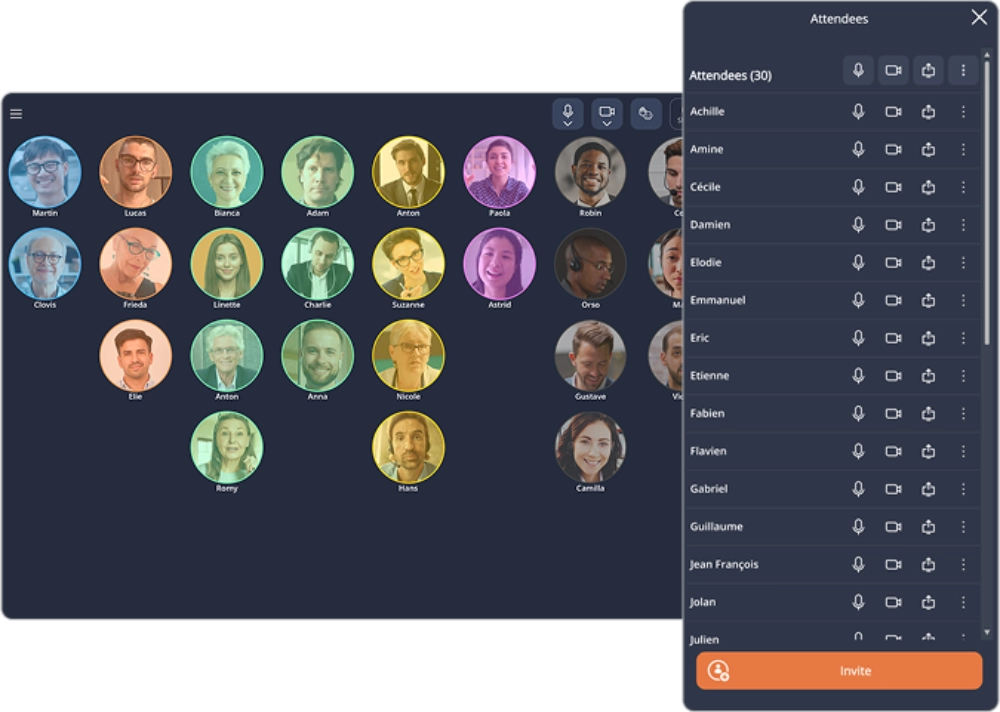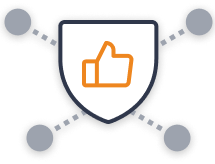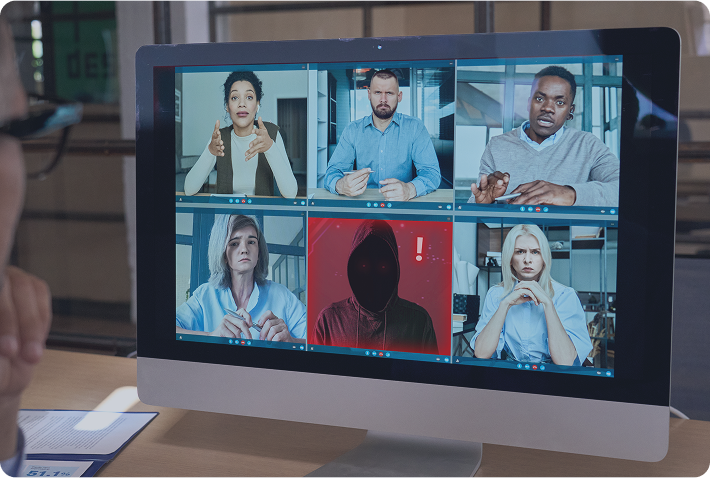Access management
Stay in control of your meetings
Effective management of access and meeting rights in Tixeo
limits intrusions and protects your sensitive communications and data.
Only your guests can participate in the discussion
Your online meetings often involve sensitive business information. Make sure every participant’s identity is verified.

Adapting the level of security
With ANSSI CSPN-certified Tixeo video conferencing, the organizer can set a higher or lower level of security,
depending on how secure the exchanges need to be.
Objective: to reduce the risk of unwanted intrusion.
| With the maximum security level activated by default, participants must create a user account and then log in to join the online meeting. Ideal for meeting specific cyber security requirements. |
 |
With a standard level of security, the organiser can share a secure invitation link to the meeting, with account identification or PIN code. Participants can join the meeting from a web browser, via a virtual waiting room. |
| Multi-factor authentication (MFA) is available by default to control access. SSO (Single Sign-On) enables easy and secure connection to video conferencing. |
![]()
Multi-factor authentication (MFA) is available by default to control access. SSO (Single Sign-On) enables easy and secure connection to video conferencing.

With a standard level of security, the organiser can share a secure invitation link to the meeting, with account identification or PIN code. Participants can join the meeting from a web browser, via a virtual waiting room.
![]()
Multi-factor authentication (MFA) is available by default to control access. SSO (Single Sign-On) enables easy and secure connection to video conferencing.
Each access request is verified

Meeting participants must confirm their identity in order to access the following :
- their personal account,
- the list of scheduled meetings,
- the directory of contacts (first and last names),
- and the instant messaging feature.
Virtual waiting room
In the case of web access to a Tixeo meeting, the guest enters the PIN code received by email and enters a virtual waiting room. The organizer checks the attendance request and approves or disapproves it.
Participants’ rights
When they join a Tixeo videoconference, participants have only minimal rights:
- communicate by audio, video or messaging,
- view shared documents.
- in Conference mode, only messaging is available to participants.

Le participant à une réunion doit confirmer son identité afin d’accéder :
- à son compte personnel,
- à la liste des réunions,
- à la liste des noms et prénoms de ses contacts,
- et à la messagerie instantanée.
Salle d’attente virtuelle
Dans le cas d’un accès web à une réunion Tixeo, l’invité renseigne le code PIN reçu par mail et entre dans une salle d’attente virtuelle. L’organisateur vérifie sa demande de participation et l’approuve ou la désapprouve.
Droits des participants
Lorsqu’ils entrent dans une visioconférence Tixeo, les participants ne possèdent que des droits minimaux, à savoir :
- communiquer en audio, vidéo ou par messagerie,
- visualiser des documents partagés.
- en mode Conférence, seule la messagerie est disponible pour les participants.
Access privileges and authorisations
With Tixeo, the roles of each user are precisely defined to limit security breaches.
Administrator
Manages subscription and meeting server settings, appoints managers and provides technical maintenance for the system.
Subscription manager
Appoints organisers, supervises subscriptions and allocated funds (number of seats, number of organisers, etc.)
User manager
Manages the user base of a server, add or remove accounts (only with TixeoPrivateCloud or TixeoServer).
Organiser
Organises online meetings and have organiser rights (screen sharing, taking the floor, excluding a participant, etc.)
Guest
Participates in videoconferences free of charge, with minimum rights when joining a videoconference.
Organiser
Organises online meetings and have organiser rights (screen sharing, taking the floor, excluding a participant, etc.)
Guest
Participates in videoconferences free of charge, with minimum rights when joining a videoconference.

Users can track more or less detailed statistics on how the solution is used, depending on their access privileges.
Benefits of Tixeo access management
Enhanced authentication

To join a Tixeo meeting with the highest level of security, you need to identify yourself on the software installed on your device.
Control of participants

Meeting attendees with a unique identifier (PIN code) wait in a virtual waiting room so that their identity can be verified. The arrival of a new participant is authorised manually.
Data protection

The partitioning of meetings reduces the risk of data leakage, particularly in physical meeting rooms equipped with video-conferencing systems.


Since 2017, the French Cybersecurity Agency (ANSSI) has renewed Tixeo’s CSPN certification three times, proof of its reliability and commitment to cybersecurity.
For a CIO or security manager, protecting access to corporate networks and resources is a top priority.
Deployed in the cloud or on-premises, Tixeo integrates easily with your LDAP or Active Directory.
For a CIO or security manager, protecting access to corporate networks and resources is a top priority.
Deployed in the cloud or on-premises, Tixeo integrates easily with your LDAP or Active Directory.
The organiser manages the meeting
Only the organiser has all the rights in a meeting to keep an eye on the participants, before and during the discussions.

Organiser’s rights
-
Share documents (screens, applications, files, etc.),
-
Grant sharing rights to another participant,
-
Withdraw the right to speak, or even the right to display the camera,
-
Exclude a participant
-
Cancelling a participant’s invitation
With Tixeo, an organiser can delegate the rights to organise and manage a meeting, right from the planning stage.
Meeting isolation
Separation of meetings is a fundamental prerequisite for Tixeo to avoid data leakage.
Why is this important?


Session isolation
Each meeting takes place in an independent process: video and audio streams and shared documents are only accessible to authorised participants.


No trace left
As soon as the meeting is closed, all the data associated with the videoconference (history, messaging, files, recordings, etc.) disappears. It is impossible to access data from one session to another.


Increased security in physical meeting rooms
In physical meeting rooms equipped with video conferencing systems, it is common to accidentally forget confidential documents exchanged during a meeting. Thanks to Tixeo’s strict partitioning and access controls, even if another meeting is held later in the same room, no information from the previous videoconference can be recovered.
Zoombombing is still a risk today
Zoombombing is the unwanted intrusion into an online meeting, generally due to a failure to manage members’ rights and access, and the massive sharing of a simple link to the meeting.

It can lead to :
- disruption to the conduct of the meeting,
- leaks of confidential information,
- shock or offend a group of minors or unwary people,
- negative repercussions on the reputation of an organisation or public authority, which may be held liable.
Two examples of zoombombing:
- In March 2025, a Zoom meeting of Franklin County (Ohio) was disrupted by the broadcast of pornographic and hateful content, shocking the public and exposing serious flaws in the videoconferencing tool.
- An online meeting of the US Federal Reserve, attended by around a hundred representatives of the major US banks, was intruded upon by an individual and offensive videos were broadcast.
How can I prevent intrusions in video conferencing?

Secure by design architecture
A Secure by Design video conferencing solution, like Tixeo, takes security criteria into account at every stage of its development.

Controlling meeting rights
Organisers must remain in control of their videoconferences, thanks to advanced rights management that optimises the efficiency of meetings.

Secure by design architecture
A Secure by Design video conferencing solution, like Tixeo, takes security criteria into account at every stage of its development.

Controlling meeting rights
Organisers must remain in control of their videoconferences, thanks to advanced rights management that optimises the efficiency of meetings.

Raising employee awareness
With the development of AI and deep fakes in video conferencing, employee training is essential to maintain the right security reflexes.

Augmented security
Tixeo’s Augmented security feature allows you to require a secret access code before entering into a critical exchange with one or more participants.

Raising employee awareness
With the development of AI and deep fakes in video conferencing, employee training is essential to maintain the right security reflexes.

Augmented security
Tixeo’s Augmented security feature allows you to require a secret access code before entering into a critical exchange with one or more participants.
For security reasons, we advise against sharing an online meeting invitation link too widely.
Tixeo complies with official recommendations


The European Union’s cybersecurity agency (ENISA) and the Cybersecurity and Infrastructure Security Agency (CISA) recommend a series of features for secure video conferencing tools such as :
- the virtual waiting room, to see and assess participants trying to access your event before granting them access
- participant rights management (screen sharing, recording or document sharing authorisations)
- the possibility for the organiser to withdraw one or more undesirable participants from the videoconference
With Tixeo, take advantage of these security features by default, to ensure the confidentiality, integrity and availability of your most critical online communications.
Organizations in sensitive sectors are now using Tixeo’s solution to secure their most confidential internal and external exchanges.
Everything you need to know about access and rights management
Definition of access management
What is access management?
Access management involves controlling user authorisations to access systems, data and IT services, often via an IAM (Identity and Access Management) solution.
What are the best practices for identity and access management (IAM)?
Best practices include centralised identity management, the use of multi-factor authentication, and the implementation of strict security principles.
Implementing an IAM solution requires centralised administration, well-defined management processes, and a robust cybersecurity policy.
What tools are used to manage access?
IAM solutions, PAM (Privileged Access Management) systems and advanced access control solutions. In addition, access should be audited regularly to detect any anomalies.
How does single sign-on work?
Single sign-on (SSO) is a rapid way of facilitating the login process by enabling a single digital identity to be used to access several applications.
Videoconference access management
Why is access management an issue for online meeting tools?
In a world where cyber-attacks are on the increase, implementing an effective security policy is essential to reduce the risks of hacking.
Companies share sensitive information during videoconferences, and this information is subject to covetousness. Recent examples of zoombombing are a reminder of the importance of effectively managing access issues for online meetings. Poor management of user roles can lead to data leaks, compromising information security. Implementing an access and rights control system is an essential challenge and an important step in software design to avoid the risks of unauthorised access.
How do you secure access to video conferencing data?
There are various rules for avoiding zoombombing situations. The access management policy is fundamental to protecting data. Secure access is based in particular on multi-factor authentication (MFA), authorisation management, control of rights and the implementation of a virtual waiting room or access via PIN code or unique identifier.
Tixeo's secure video conferencing solution includes advanced access and rights management as well as meeting partitioning. Several levels of security are available to adapt protection to the criticality of exchanges. Another of the best ways of limiting intrusions is to limit the sharing of meeting connection links. Access privileges are assigned on the basis of roles within the organisation, for precise and efficient management of authorisations.
What are the risks associated with poor access management?
Sharing a link to an online meeting has become widespread. However, widespread distribution of these invitations exposes organisations to the risks of zoombombing and data theft. Unauthorised intrusions into highly confidential or secret communications can have serious consequences for an organisation's reputation or even for national stability.
A case in point was in 2024, when a confidential videoconference exchange between German army officers on the war in Ukraine was leaked and sparked diplomatic concern.
The solution chosen by organisations must be compliant with cybersecurity and data protection regulations.
Access and rights management issues and challenges
Why is it important to manage access?
The main reason is that poor access management exposes the organisation to the risk of hacking and unauthorised access, and jeopardises its IT security. IT Departments need to implement an access management policy that complies with IT security requirements and current regulations. This also involves managing access to employees' workstations, whether they are in the office, working in a hybrid environment or teleworking.
Tixeo access and rights management allows you to strengthen the security of your hybrid work environment.
What are the challenges of access management?
Access management challenges require a rigorous approach to protect against the risks of zoombombing, security problems and identity theft. It involves the complex management of identities on a large scale, reducing the possibility of unauthorised access to data.
One of the advantages of Tixeo is its robust access control, which is essential for protecting sensitive information exchanged between employees. What's more, the solution complies with various European and international standards, such as those of ENISA and CISA, concerning the security of online communications.
